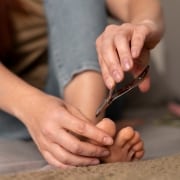3 At-Home Remedies for Ingrown Toenails
Ingrown toenails can be a serious hassle. Not only can they be extremely painful, but they can also impact your daily life. Luckily, you can do a few things at home to find relief.Keep reading to learn 3 at-home remedies for those annoying ingrown toenails.
Soaking
Soaking your ingrown toenail is one of the most popular ways to reduce swelling and ease pain. First, try soaking your foot in warm, soapy water for about 20 minutes. While most soaps will work, we recommend Castile soap. Another tip is to add Epsom salts, which can provide additional benefit. If a water soak doesn’t bring any relief, consider soaking your foot in apple cider vinegar. This substance is said to have anti-inflammatory, antiseptic, and pain-relieving qualities. To try this remedy, combine water with ¼ cup apple cider vinegar in a large bowl, then soak for about 20 minutes.
Need professional help for an ingrown toenail? For trusted ingrown toenail treatment in Austin, TX, or the surrounding area, contact Dr. Jeffery W. LaMour today!
Applying Ointment
Experts also recommend applying antiseptic ointment to the area. Most over-the-counter antiseptic ointments or creams should work, which are known to encourage healing and lower the chance of infection. Make sure you apply the ointment as directed on the package instructions, and use it up to three times daily. Common brand name ointments include Neosporin, Polysporin, and Bactroban.
Wearing the Right Shoes and Socks
If you wear the wrong footwear or socks, this can actually be the leading cause of an ingrown toenail. In order to give your toenail enough room to breathe and grow properly, it’s important to wear loose, comfortable shoes and socks.
Looking for professional care instead? To work with a leading podiatrist in Austin, TX, call Dr. Jeffery W. LaMour today to schedule an appointment!








